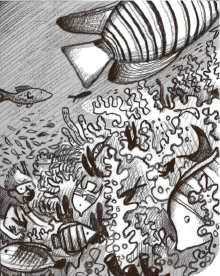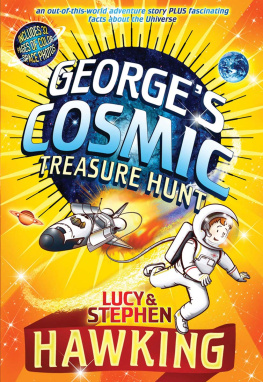Contents
Also available by Lucy and Stephen Hawking:
Georges Secret Key to the Universe
Georges Cosmic Treasure Hunt
George and the Big Bang
George and the Unbreakable Code
For details of Stephen Hawkings books for adult readers, see:
www.hawking.org.uk

RHCP DIGITAL
UK | USA | Canada | Ireland | Australia
India | New Zealand | South Africa
RHCP Digital is part of the Penguin Random House group of companies whose addresses can be found at global.penguinrandomhouse.com.
www.penguin.co.uk
www.puffin.co.uk
www.ladybird.co.uk

First published 2016
This ebook published 2016
Text copyright Lucy Hawking, 2016
Illustrations by Garry Parsons
Illustrations/Diagrams copyright Random House Childrens Publishers, 2016
Cover artwork, design and lettering Blacksheep-uk
Cover space suits photography Superstock
Building Rockets for Mars by Allyson Thomas 2015 National Aeronautics and Space Administration, an Agency of the United States Government. Used with Permission.
The moral right of the author and illustrator has been asserted
A CIP catalogue record for this book is available from the British Library
ISBN: 9781448174706
All correspondence to:
RHCP Digital
Penguin Random House Childrens
80 Strand, London WC2R 0RL
I dont know what I may seem to the world, but as to myself, I seem to have been only like a boy playing on the sea-shore and diverting myself in now and then finding a smoother pebble or a prettier shell than ordinary, whilst the great ocean of truth lay all undiscovered before me.
Isaac Newton
THE LATEST SCIENTIFIC IDEAS!
As you read the story, you will come across some fabulous science essays and information. These will really help bring the topics you read about to life, and are written by the following well-respected experts:
The Oceans of Earth
by Professor Ros E. M. Rickaby
Department of Earth Sciences, University of Oxford
Volcanoes on Earth, in our Solar System and Beyond
by Professor Tamsin A. Mather
Department of Earth Sciences, University of Oxford
Building Rockets for Mars
by Allyson Thomas
Aerospace Engineer, NASA
What are Chemical Elements and Where Do They Come From?
by Dr Toby Blench
Research Chemist
Life on Mars
by Kellie Geradi
Mars Astronaut
Doing Experiments on Mars
by Katie King
MSci, University of Cambridge
What is Reality?
by Dr James B Glattfelder
Complex Systems Theorist
Medically Speaking, is Suspended Animation Realistic?
by Dr David Warmflash, M.D.
Is There Anyone Out There?
by Professor Stephen Hawking
University of Cambridge
What is Quantum Teleportation?
by Dr Stuart Rankin
University Information Services, University of Cambridge
The Overview Effect
By Dr Richard Garriott de Cayeux
ISS Astronaut
With very special thanks to Sue Cook,
the George series non-fiction editor
And to Stuart Rankin.
THE PINK-FRINGED CORAL waved gently in the soft blue ocean as a shoal of millions of tiny silver fish dived past it. Swimming as one, the swarm of fish jackknifed and suddenly shot upwards and away, towards the turquoise water above Georges head. A larger fish lay up there, hovering between George and the sunshine on the surface of the ocean. The huge fish moved slowly across his field of vision, as stately and as well armoured as any battleship.
On the floor of the ocean bed, where the coral reef dropped away to the sandy ground, little creatures scuttled along, waving their pincers furiously as though a catch would swim straight into them. Wriggly sand worms snaked around them, creating curly patterns in the loose material on the sea bed.

The Oceans of Earth
Earth our blue planet is exceptional in our solar system as it is nearly three quarters covered by the oceans. But why are our oceans here? Intriguingly, Earths oceans arrived from outer space. When the Earth was forming, it was too hot for water to condense on the planet. Just as tall mountains have snowy white tops above the snow-line, where the cooling of the atmosphere with height allows snow to persist, so too was there a gradient of cooling to a snow-line away from the ferociously hot early Sun.
Temperatures cold enough for ice grains to form were only reached further out in the solar system, in the asteroid belt somewhere between Mars and Jupiter. Earths oceans, therefore, had to be imported: many think this happened with a shower of water-rich meteorites or comets from the asteroid belt bombarding the early Earth.
Since then these extraterrestrial water molecules have been neither created nor destroyed! For the subsequent 3.8 billion years (the first evidence for liquid water comes from sediments of this age on southwest Greenland), our oceans have been trapped on the Earths surface, where they go round in two cycles.
First, the warmth of the Sun in the tropics turns some of the ocean to vapour (just as you see coming from a boiling kettle or steam engine) and clouds. Rising clouds cool and create rain, which trickles across the land and into streams and rivers before gushing back into the oceans.
Second, small amounts of water pop down into Earths interior, through deep-sea trenches in the ocean crust. This water rapidly returns to the surface through volcanoes or hydrothermal vents.
So the very same water molecules coming out of your taps at home have witnessed every second of Earths history, from before the start of self-reproducing life itself to the emergence of multi-celled organisms. Most probably, these water molecules passed through a dinosaur at some point. You could be making a cup of tea out of water that was once slurped down by a thirsty T. Rex!
What makes water so extraordinary and the oceans so key to life is its ability to dissolve things. Put some salt in a glass of water, or sugar in your tea, and those crystals will disappear or dissolve. This is because of the slight charge or polarity of water molecules, which attracts elements into solution.
Water is even better at dissolving things if it is made a little acidic, by reacting with something like carbon dioxide to make carbonic acid. Take a sip of fizzy water (those bubbles are carbon dioxide) and see if you can taste the acidity; both my sons wrinkle their noses on doing so. Now, when water cycles from the oceans to clouds, then to rain and down rivers, it becomes a bit acidic by reacting with carbon dioxide in our atmosphere. As a result, this carbonated rainwater dissolves elements out of the land (this is called













